p.390
p.398
p.406
p.414
p.423
p.431
p.440
p.448
p.456
3D Photogrammetric Reconstruction by Drone Scanning for FE Analysis and Crack Pattern Mapping of the “Bridge of the Towers”, Spoleto
Abstract:
Technological advances in the digital camera industry and computing resources make the use of photogrammetry a very fast, low-cost, contactless and non-destructive technique. It can represent a good alternative to obtain 3D information for monitoring and conservation of cultural heritage assets, especially where it is not possible to use 3D laser scanners and also in situations where areas to be inspected are not easily accessible [1]. Resolution generally depends on the number of images, their quality and the level of overlap between them, as well as hardware and software capabilities. Starting from 2D aerial or terrestrial photographic images, photogrammetry allows to reconstruct a 3D model in the form of a "point cloud" and also to derive accurate 3D measurements of large architectural elements.This paper is about stereo-photogrammetric scanning by drone performed by MENCI software s.r.l. aimed at the definition of the state of conservation of the “Bridge of the Towers” in Spoleto and its long term preservation without building scaffoldings. It was performed within the RoMA (Resilience enhancement of a Metropolitan Area) project, through an agreement between the “Italian National Agency for New Technologies, Energy and Sustainable Economic Development” (ENEA) and the “Italian Ministry of Cultural Heritage and Activities” (MIBACT).Photogrammetric scanning and FE modelling were applied within the project together with many other monitoring techniques in order to assess the bridge cracks pattern and its structural health by a multidisciplinary approach that allows their mutual validation [2].As one of the most important problems in the use of photogrammetric 3D reconstruction is the considerable demand in terms of hardware and software resources for images processing and data storage, thanks to the HPC (High Performance Computing) resources provided by the CRESCO infrastructure (Research Computational Centre on Complex Systems), it was possible to analyse and process a large amount of high-resolution photos in order to detect the crack pattern and to assess the actual damage state to be monitored over time [3].
Info:
Periodical:
Pages:
423-430
Citation:
Online since:
July 2017
Price:
Сopyright:
© 2017 Trans Tech Publications Ltd. All Rights Reserved
Share:
Citation:


